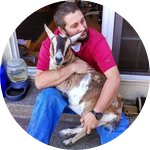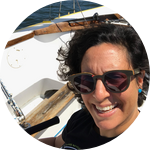About This Project
Smartwatches have the same sensors used on buoys to measure waves. We hypothesize that we can extract wave height and amplitude from motion data registered by smartwatches. This project will develop the data processing protocols to differentiate between wave and other types of motion when a watch is in the water. We will use our software to make a free app that lets anyone collect and view data using a smartwatch, and makes it easy for surfers and swimmers to contribute to science.
Ask the Scientists
Join The DiscussionWhat is the context of this research?
Coastal ocean data are currently sparse and generally accessible only with a time delay of hours to months. But Americans take 2 billion trips to the coast each year and 40% of Americans live in a coastal county. Coastal scientists, communities, and businesses need not only more data but up-to-date data, suitable for monitoring and planning resiliency on the pace and scale at which ocean changes are happening.
We want to make it easier and cheaper for anyone to fill the gaps in existing datasets. Consumer electronics with our easy-to-use app can give scientists unprecedented control over their data collection at a lower cost than is currently possible. They will also be able to easily access and use coastal ocean data contributed by surfers and swimmers.
What is the significance of this project?
Oceanographers are building ocean-sensing networks today using the same techniques they used in the 1980s. This project will develop a completely new method for collecting wave and water conditions.
Our tests so far confirm that smartwatch temperature and pressure sensors operate at or exceeding listed instrument capabilities, and can be used to monitor coastal ocean conditions when used as a scientific instrument. If smartwatch motion sensors perform similarly, then measuring waves with smartwatches would significantly enhance the utility of smartwatch data collection capabilities. But measuring waves requires more sophistication than measuring temperature and pressure: we need an algorithm that separates wave motion from human motion.
What are the goals of the project?
The primary goal of this project is to determine whether the motion sensors on a smartwatch can be used to determine local wave height and frequency. We will gather data while surfing and swimming, write code, transform motion data into wave conditions, and then evaluate data accuracy.
Our secondary goal is to increase access to ocean data. Anyone who wants to collect their own data with a smartwatch or view data contributed by others can download our free app from Apple's App Store. Scientists who want access to raw, contributed data will be able to use it in database/spreadsheet form. All data from this project will be publicly hosted Github, along with the processing code.
Budget
We do not currently have any funds to complete this work.
App development and data processing funds will be used to secure dedicated time from key team members. This includes working with (1) Phil, our SwiftUI developer, to optimize sampling within the app for surfers and swimmers; and (2) Michelle, our data scientist, to develop the wave extraction algorithm and build the data processing pipeline in Python. Software funds include subscriptions to ChatGPT and PyCharm.
Field gear includes cold-water gear (wetsuits and float buoys) to allow team members to use the app in Puget Sound during alpha testing as surfers and swimmers would. Hardware includes a smartwatch and watch band for beta testing with local surfers and swimmers.
Outreach funds will keep our website online for 6 months, so we can effectively build a public presence that attracts additional beta testers, and eventually, lets people know they can use our app to collect and view data for themselves.
Endorsed by
 Project Timeline
Project Timeline
The major milestones for this project revolve around coding to translate smartwatch motion into wave data, field testing our algorithm and the app that houses it, iterating, and publishing a revised app to the app store. We will keep project backers informed of our progress through Lab Notes, on social media, through our website, and at ocean sciences conferences.
Mar 27, 2024
Project Launched
Apr 01, 2024
Project Launch
Apr 15, 2024
Alpha testing: Kim and Virginia collect wave data with smartwatches
May 01, 2024
Data processing: Michelle extracts wave height and frequency from the wave data
Jun 01, 2024
App development: Phil optimizes sampling in the app for collecting wave data
Meet the Team
Team Bio
Tini Scientific was founded in 2022 by Kim and Virginia. Armed with expertise in oceanography, ecology, technology, and pop culture, they are creating new data sources and data pipelines with innovative, low-cost sensor networks. Our dynamite team also includes Phil Parham, a seasoned Apple app developer who loves clean code, and Michelle Weirathmueller, a data scientist who loves transforming complex data sets.
Kim Martini
Fueled by a fascination with new technology and adventure, Kim has been throwing expensive s**t into the ocean for almost 20 years. She is an expert in oceanographic sensor and system design, having worked at the UW Applied Physics Lab, University of Alaska Fairbanks, NOAA PMEL and Sea-Bird Scientific. Her current focus is expanding ocean observations through system design and data delivery, finding practical solutions to challenging problems. She has collaborated with academic, industry and government scientists globally, and is a regularly invited speaker with over a dozen interviews on major news media. Kim is a trusted source of scientific information for scientists and the public.
Kim received her PhD in Physical Oceanography from the University of Washington. She also holds a MS in Physics, a BS in Physics and a BA in Fine Art from SUNY Albany. She is also a Level II Certified US Sailing Instructor.
Virginia Schutte
Virginia is an award-winning storyteller, strategist, and trainer who is unstoppably and loudly enthusiastic about how science makes life better. She decided to save the world in elementary school after she read A ring of Endless Light, with a heroine who saves sick dolphins by talking to them with her mind. While a career in dolphin telepathy ultimately didn’t work out, Virginia channeled her love of the ocean into earning an Ecology PhD in 2014. Since then, she has worked to diversify how people interact with science digitally. She has created and led digital engagement programs, designed communications and marketing strategies, and trained scientists to identify and meet their communications goals. Her expertise in telling stories using unexpected media spans platforms and includes outputs ranging from a science fashion campaign on Instagram to candidly connecting with an audience on Reddit.
Virginia received her PhD in Ecology from the University of Georgia. She also holds a BS in Biology and was a Morehead Scholar at the University of North Carolina at Chapel Hill. In addition, she holds a lapsed AAUS Scientific Diver certification (lapse caused by her 2 kids- hooray!) and a non-lapsed FFT2 qualification to work with wildland fire.
Lab Notes
Nothing posted yet.
Additional Information
This project is a follow-on from a past project funded through experiment.com: "Can we use a smartwatch for coastal ocean monitoring?". Results from this second project will be integrated into the work that we started in late 2022 that aims to turn smartwatches into research-worthy smart sensors. You can track our progress so far through the Lab Notes published on our 2022 project page.
Project Backers
- 4Backers
- 101%Funded
- $10,080Total Donations
- $2,520.00Average Donation


